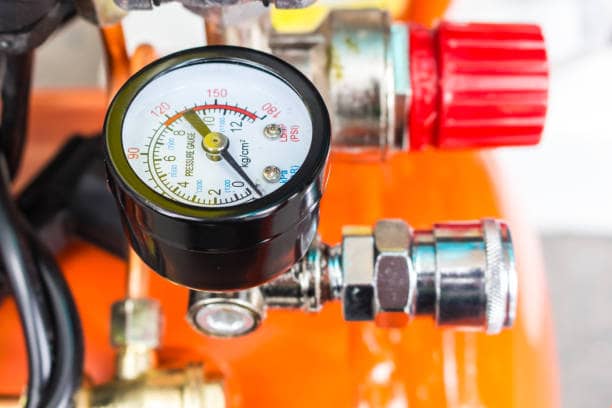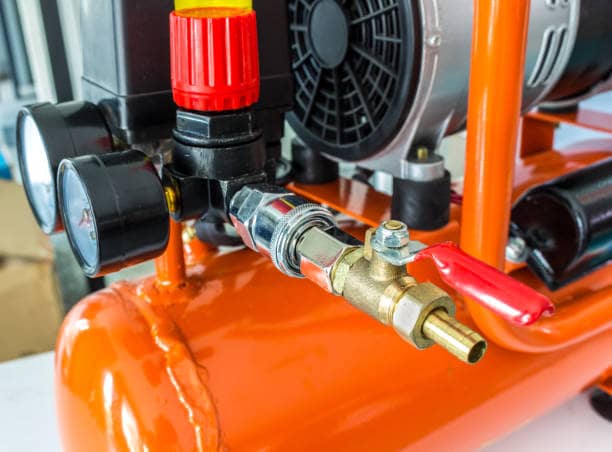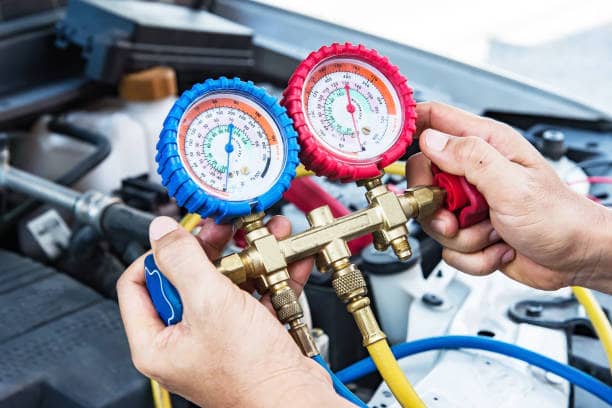Many independent craftspeople and companies focus on investing in compressors for many good reasons. These machines have applications in life.
If you have invested in one, you may have heard of the term “duty cycles.” This factor is essential for compressors’ longevity or what you should use them for.
However, there are still many people confused with this rating. So we came up with this post related to air compressor duty cycles explained to help you better understand it.
So let’s scroll down to see more!
Air Compressor Duty Cycles Explained
What Is The Duty Cycle Rating?
This rating usually appears as a percentage. This term refers to the time portion the pump of compressors runs relative to the total cycle time of this compressor.
The total cycle time involves the time compressors need to hit cut-out pressures, turn off, and get cut-in pressures when used.
However, as defined by some manufacturers, this rating refers to the period compressors can deliver air at one specific output and pressure.
It is the main cause of confusion among many users as it does not necessarily correlate with the compressor pump’s run time.
But we can consider this rating as the percentage of time compressors’ pumps should be operated in a specific period.
For instance, if the rating of your compressor is 25%, its pump will not operate for longer than 15 minutes in one hour.
Why Does This Rating Matter?
This rating is essential for any compressor as it lets users know what application their machine is suitable for.
In addition, it is also related to keeping their compressors’ longevity.
Anything beyond a compressor’s recommended duty cycles may cause premature wear out or damage its pump components.
Compare Duty Cycle Percentages
Compressor manufacturers usually include the recommended rating in the owner’s manual or product manual.
Alternatively, you can also find it in marketing materials or packaging. It is one of the general recommendations to help prolong the product’s life.
25%
For compressors that feature a 25% rating, their pump should run approximately one-quarter of one total cycle.
For example, if the total cycle of these compressors takes 60 seconds (one minute). Hence, you need to avoid the pump running for 15 seconds.
This rating isn’t popular but works well with smaller compressors built for light use, such as inflating sports equipment or small tires.
They also work well with smaller applications that need intermittent air power, like portable compressors utilized by independent craftspeople.
30%
If you own one of the compressors with a 30% rating, the run time is about 1/3 of its total run time.
Consequently, if its cycle time is 60 seconds, the run time will be approximately 20 seconds.
When running, your machine must stop for about forty seconds between every 20 seconds of active usage.
Compressors with a 30% rating will work well for moderate applications where you use your tools but continuously is unnecessary, such as in a garage where parts of the motor must be unfastened and fastened every few minutes.
50%
A 50% rating is found in various compressors with many capabilities and sizes.
It is shown that running the compressor pump for thirty minutes of each hour is okay. As it allows compressors more operation, making this rating more popular.
50% rating compressors are typically utilized for medium-scale jobs requiring only intermittent air power, such as cutting, inflating, stapling, drilling, automotive repair, cleaning, and some minor paint jobs.
75%
A compressor with a 75% rating is ideal. These machines need a short rest/ cooling period.
Their pumps can run 45 seconds for each minute, 7 1/2 minutes for every 10 minutes, and 45 minutes for each hour.
This kind of duty cycle rating is more common in larger compressors, like models used in woodworking or automotive shops, where downtime is required to be minimal.
100%
If you own one of the models with a 100% rating, you can expect it to produce pressurized air during its entire cycle time.
These machines are ideal for works requiring continuous airflow for hours or minutes, such as spray painters and pneumatic sanders.
For compressors to deliver 100% duty cycles, their engines must come with one cooling component. If not, the constant pressurization might cause their motor to overheat.
Generally, 100% duty cycles should be a standard for any compressor utilized in factory settings.
Continuous And Intermittent Duty Cycles
It should be helpful to divide the duty cycle rating into two main categories, including continuous and intermittent.
Continuous Type
Most continuous-duty compressors are the rotary screw kind. They are often utilized in factory/industrial settings.
Piston compressors may provide continuous usage if not a true continuous duty.
Those machines are ideal for applications in that long-term continuous operation is necessary. These include:
- Painting (large surfaces/automotive).
- Manufacturing applications.
- Sanding.
Intermittent Type
Compressors with a duty cycle of less than 100% rating can be considered intermittent.
Intermittent duty models are more than enough for various homeowners, auto mechanics, and general contractors.
Intermittent air power works well with most basic applications as you only utilize air in fairly short bursts. These include:
- Cutting.
- Drilling.
- Hammering.
- Stapling/Nailing.
- Cleaning (air blower).
- Light-duty craft painting.
- Powering impact wrenches.
- Inflating sports equipment and tires.
How To Determine the Duty Cycle of an Air Compressor?
One of the fastest ways to determine the compressor’s duty cycle rating is to check out the user manual. You can find it along with other specifications.
In addition, going online can also help you determine the rating of your machine.
Here is how to do that:
Step 1: Go to Google.com (or any other search engine, such as Bing and Yahoo)
Step 2: Enter your compressor make and model number
Step 3: After your model number, you should insert the words “duty cycle” (without quotes) to see the result, which will pop up shortly after.
Contacting the manufacturer is your best bet if it is not listed there.
If you have not yet invested in compressors but prefer to know their duty cycles, the online page may list this rating in the specs section.
If not, it is okay to download a user manual from the manufacturer’s web.
If the methods do not work, it is time to contact the manufacturer for advice.
Tips To Remember While Picking a Duty Cycle Rating
- This rating might be affected by ambient temperature, kind of motor, and load on compressors.
- Pick one of the proper compressors is critical to meeting your required CFM. (read more: Increase CFM On Air Compressor)
- The air compressor’s duty cycle is decided by how long it can operate at a consistent load without stopping.
- Rotary screw compressors have longer duty cycles than their reciprocating counterparts.
- We recommend using one of the excellent belt guards and installing one pressure switch to protect the electric motor from overheating if operating continuously for more than half an hour.
This rating is one of the critical aspects you need to consider when selecting a compressor, but it is not your only concern when purchasing one.
So you must consider other essential aspects, such as the cooling system and compressor motor, before making the final decision.
FAQs
How Can I Extend This Rating of Compressors
If you prefer to run the machine for more extended than its recommended duty cycle, you can consider and apply several ways below.
- Invest in a larger compressor, which will enable you to operate more air tools and devices simultaneously and lower the period of time that each tool is running.
- Utilize one pressure regulator per tool. It will reduce the air going into your device and decrease the air compressors needed to produce.
- Use greasy or lubricated rotary screw air compressors, which reduce the heat build-up as they are continuously cooled with oil rather than ambient air like reciprocating compressors.
- Mount an after-cooler on the compressor. It will cool the air before it gets into the tank, helping it last longer.
- Mount one belt guard on the electric engine to prevent it from burnout or damage due to debris and dust contaminating the bearings and belts inside the tank in a compressor.
Which Compressors Are Ideal for Continuous And Intermittent Duty?
Intermittent Duty Usage
- Single-Stage
- QR-25
- QP
Continuous Duty
- QGS
- QGD
- QSI
- QGDV
- QGV
Can I Prevent Over-Cycling?
If air compressors are over-cycled, they will overheat and get damaged.
To prevent it, you should choose a machine with the proper duty cycles for your applications.
Also, you must ensure that your compressor features enough cooling capacity.
You can achieve it by picking one of the models with a larger tank size or a higher horsepower rating.
It’s essential to follow the instructions from the manufacturer on how to use compressors.
That way, you can prevent over-cycling and allow your compressor to last longer.
How to Lengthen the Cycle Time?
Here are several methods to lengthen the cycle time of your compressor and make it more efficient:
- Use one larger tank.
- Try one wider pressure band.
- Reduce the pressure between the compressor and the main tank.
How to Calculate the Duty Cycle of Air Compressors?
This rating is calculated by dividing the amount of time the compressor can operate before resting by its total run time.
In The Nutshell
Hopefully, through our air compressor duty cycles explained, you better understand this rating.
The term “Duty Cycle” tells you how long your compressor is rated to operate versus how long it should rest. It is a gauge for how “heavy duty” the motor is.
It plays an essential role in determining what applications a compressor is suitable for. Further, it helps preserve the compressor’s longevity.
If this article was helpful to you, please share this post!
Thanks for stopping by!






